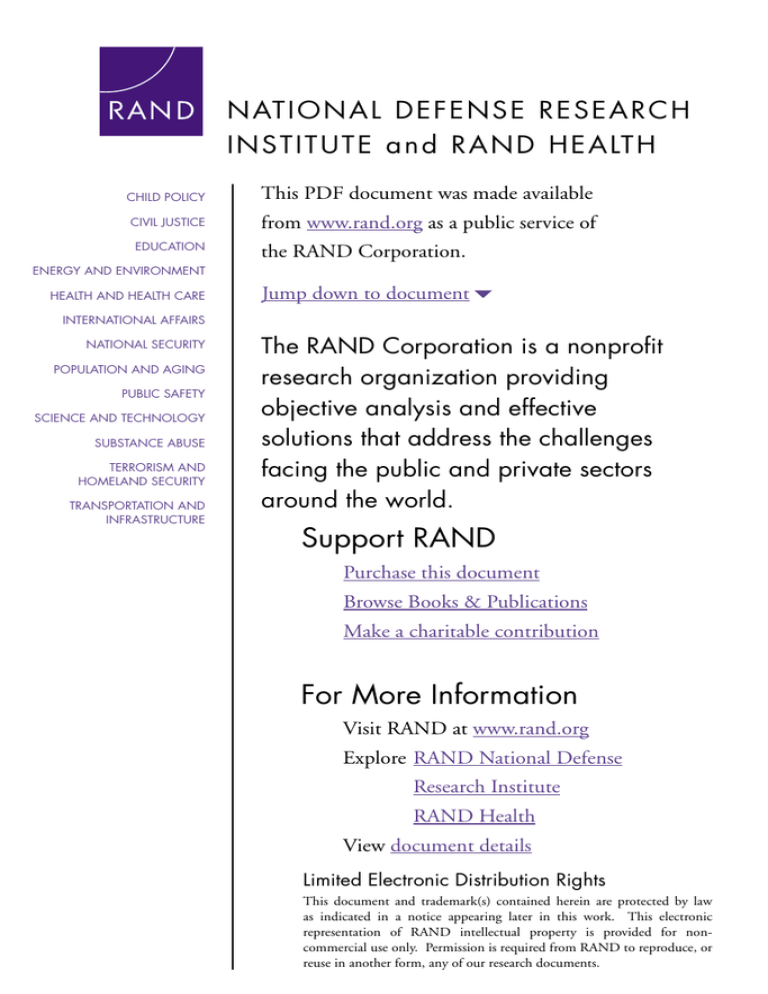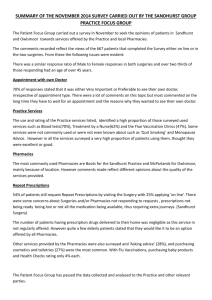
NAT I O N AL DE F ENSE RESE ARCH
IN S T I T U T E a nd RAND HEALTH
CHILD POLICY
This PDF document was made available
CIVIL JUSTICE
from www.rand.org as a public service of
EDUCATION
the RAND Corporation.
ENERGY AND ENVIRONMENT
HEALTH AND HEALTH CARE
Jump down to document6
INTERNATIONAL AFFAIRS
NATIONAL SECURITY
POPULATION AND AGING
PUBLIC SAFETY
SCIENCE AND TECHNOLOGY
SUBSTANCE ABUSE
TERRORISM AND
HOMELAND SECURITY
TRANSPORTATION AND
INFRASTRUCTURE
The RAND Corporation is a nonprofit
research organization providing
objective analysis and effective
solutions that address the challenges
facing the public and private sectors
around the world.
Support RAND
Purchase this document
Browse Books & Publications
Make a charitable contribution
For More Information
Visit RAND at www.rand.org
Explore RAND National Defense
Research Institute
RAND Health
View document details
Limited Electronic Distribution Rights
This document and trademark(s) contained herein are protected by law
as indicated in a notice appearing later in this work. This electronic
representation of RAND intellectual property is provided for noncommercial use only. Permission is required from RAND to reproduce, or
reuse in another form, any of our research documents.
This product is part of the RAND Corporation monograph series.
RAND monographs present major research findings that address the
challenges facing the public and private sectors. All RAND monographs undergo rigorous peer review to ensure high standards for
research quality and objectivity.
Determinants of Dispensing
Location in the TRICARE
Senior Pharmacy Program
Jesse D. Malkin
Geoffrey Joyce
Jennifer Pace
Thomas Croghan
Prepared for the Office of the Secretary of Defense
Approved for public release; distribution unlimited
4HE RESEARCH DESCRIBED IN THIS REPORT WAS SPONSORED BY THE /FFICE OF
THE 3ECRETARY OF $EFENSE /3$4HE RESEARCH WAS CONDUCTED JOINTLY
BY THE #ENTER FOR -ILITARY (EALTH 0OLICY 2ESEARCH A 2!.$ (EALTH
PROGRAMANDTHE&ORCESAND2ESOURCES0OLICY#ENTERA2!.$.ATIONAL
$EFENSE 2ESEARCH )NSTITUTE .$2) PROGRAM .$2) IS A FEDERALLY
FUNDED RESEARCH AND DEVELOPMENT CENTER SUPPORTED BY THE /3$ THE
*OINT3TAFFTHEUNIFIEDCOMMANDSANDTHEDEFENSEAGENCIESUNDER#ONTRACT
$!37#
,IBRARYOF#ONGRESS#ATALOGINGIN0UBLICATION$ATA
$ETERMINANTSOFDISPENSINGLOCATIONINTHE42)#!2%SENIORPHARMACYPROGRAM
*ESSE-ALKIN;ETAL=
PCM
h-'v
)NCLUDESBIBLIOGRAPHICALREFERENCES
)3".PBK
-EDICINE-ILITARY5NITED3TATES#OSTS$RUGS5NITED3TATES#OST
CONTROL/LDERVETERANS-EDICALCARE5NITED3TATES#OSTS2ETIREDMILITARY
PERSONNEL-EDICALCARE5NITED3TATES#OSTS-ILITARYDEPENDENTS-EDICAL
CARE5NITED3TATES#OSTS5NITED3TATES!RMED&ORCES-EDICALCARE#OSTS
-ANAGEDCAREPLANS-EDICALCARE5NITED3TATES)-ALKIN*ESSE$n
5($
ggDC
4HE2!.$#ORPORATIONISANONPROFITRESEARCHORGANIZATIONPROVIDING
OBJECTIVE ANALYSIS AND EFFECTIVE SOLUTIONS THAT ADDRESS THE CHALLENGES
FACING THE PUBLIC AND PRIVATE SECTORS AROUND THE WORLD 2!.$S
PUBLICATIONSDONOTNECESSARILYREFLECTTHEOPINIONSOFITSRESEARCHCLIENTS
ANDSPONSORS
®ISAREGISTEREDTRADEMARK
Ú#OPYRIGHT2!.$#ORPORATION
!LL RIGHTS RESERVED .O PART OF THIS BOOK MAY BE REPRODUCED IN ANY
FORM BY ANY ELECTRONIC OR MECHANICAL MEANS INCLUDING PHOTOCOPYING
RECORDING OR INFORMATION STORAGE AND RETRIEVAL WITHOUT PERMISSION IN
WRITINGFROM2!.$
0UBLISHEDBYTHE2!.$#ORPORATION
-AIN3TREET0/"OX3ANTA-ONICA#!
3OUTH(AYES3TREET!RLINGTON6!
.ORTH#RAIG3TREET3UITE0ITTSBURGH0!
2!.$52,HTTPWWWRANDORG
4OORDER2!.$DOCUMENTSORTOOBTAINADDITIONALINFORMATIONCONTACT
$ISTRIBUTION3ERVICES4ELEPHONE
&AX%MAILORDER RANDORG
Summary
The MHS serves approximately 8.6 million eligible beneficiaries, including active-duty military personnel and their family members (dependents), retired military personnel and their dependents, and surviving dependents of deceased military personnel. TRICARE, the program that administers health care for the DoD, includes a pharmacy
benefit that provides coverage for virtually all U.S. Food and Drug
Administration (FDA)-approved prescription medications.1 Prior to
fiscal year (FY) 2001, elderly military retirees and their dependents
who wished to use their military benefits to fill a prescription could do
so only at a MTF outpatient pharmacy. However, some drugs that were
frequently prescribed by civilian providers were not always available at
MTFs because of formulary restrictions.2 As of FY 2001, DoD introduced a new program for elderly military retirees and their dependents,
entitled TRICARE Senior Rx (TSRx). TSRx beneficiaries can now fill
their prescriptions at any of four points of service: (1) outpatient pharmacies at MTFs; (2) the TRICARE Mail Order Pharmacy (TMOP),3
currently administered by Express Scripts Inc.; (3) retail pharmacies
1 Exceptions are medications to treat cosmetic conditions resulting from the normal aging
process, medications whose sole use is to stimulate hair growth, medications for investigational
use, medications for obesity and/or weight reduction, medications for smoking cessation, and
some prescription vitamins.
2 The term “formulary restriction” is used in the health services literature to refer to the practice
of choosing to provide some brands of a particular class of drugs and not to provide others.
3 The TRICARE Mail Order Pharmacy was formerly known as the National Mail Order Phar-
macy (NMOP). The TMOP is suitable for ongoing prescriptions (that is, prescriptions used
to treat chronic conditions).
xi
xii
Determinants of Dispensing Location
contracted by regional TRICARE contractors (referred to as “network”
pharmacies); and (4) non-network retail pharmacies.
The TMOP dispenses drugs for chronic conditions. Although it
cannot dispense a few drugs, such as atorvastatin, without proof of
medical necessity,4 the overwhelming majority of drugs for chronic
conditions are available. Retail pharmacies have completely open formularies: TRICARE reimburses them for all prescriptions except those
specifically excluded from TRICARE coverage.
The location at which a TSRx beneficiary chooses to obtain a prescription drug affects the cost of that drug to the beneficiary. Elderly
beneficiaries pay no co-payment for pharmacy items (either generic
or name-brand) obtained from a MTF. The co-payment for items obtained through the TMOP and network retail pharmacies is $3.00 for
a generic drug (up to a 90-day supply is available through the TMOP)
and $9.00 for a name-brand drug. Non-network retail pharmacies
charge a higher co-pay. The FY 2000 National Defense Authorization
Act proposes establishing a Uniform Formulary, which will add a third
tier for non-preferred brands (with a co-pay of $22.00) to the current
two-tier structure and will require TMOP to have an open formulary.
The location at which a TSRx beneficiary chooses to obtain a prescription drug also affects the acquisition cost (defined here as the estimated ingredient cost of the drug to DoD, ignoring dispensing fees,
co-payments, and sales taxes). Drugs dispensed through MTFs and the
TMOP are purchased at prices negotiated by the Defense Supply Center in Philadelphia (DSCP) and the Department of Veterans Affairs.
By contrast, drugs dispensed through TRICARE retail network pharmacies are reimbursed at rates negotiated by TRICARE managed care
support contractors. The retail prices typically are considerably higher
than those negotiated by the DSCP and the Veterans’ Administration
4 Medical necessity is determined on an individual basis, based on a review of information
provided by the beneficiary’s provider. According to the DoD Pharmacoeconomic Center’s
(PEC’s) Web site, “reasons why a specific medication may be considered medically necessary
include, but are not limited to: (1) an allergic reaction to the preferred or contracted medication, (2) a side effect or adverse reaction to the preferred or contracted medication, or (3)
failure to achieve the desired effect with the preferred or contracted medication.” In contrast,
prior authorization requirements are designed to ensure that certain drugs are used by targeted
beneficiaries for whom the drugs are most cost-effective and safe.
Summary
xiii
(VA). In principle, therefore, DoD could reduce its pharmacy acquisition costs by shifting prescription workload from retail pharmacies to
MTFs and/or the TMOP.
The purpose of the present study was to gather information about
where TSRx beneficiaries receive their medications and what factors
influence these choices, and to provide a basis for developing policy
options that can improve DoD’s ability to manage the costs of the
TSRx program. Specifically, the study sought to answer the following
questions:
• What were the most-frequently dispensed and highest-cost drugs
and drug classes at each of the three dispensing locations in FY
2002?
• To what extent did ingredient costs differ by dispensing location?
• How did use of each dispensing location change over the course
of the year?
• How did beneficiaries’ proximity to MTFs influence their use of
MTF pharmacies, the TMOP, and retail pharmacies?
• Were MTF formulary restrictions associated with higher rates of
retail dispensing?
• Do the patterns observed for TSRx beneficiaries also hold for
45- to 64-year-old, non–active-duty MHS beneficiaries (most of
whom will be TSRx beneficiaries in the future)?
Approach
The study focused on prescriptions filled in FY 2002 by TRICARE
beneficiaries aged 65 and over as well as those, ages 45 to 64, who were
not active duty. The sample of TSRx beneficiaries consisted of 1.8 million eligibles, to whom 54 million prescriptions were dispensed.
A data set was assembled by linking TRICARE pharmacy claims
data from the Pharmacy Data Transaction System (PDTS) to information about military beneficiaries and the MTFs closest to their residential ZIP codes. PDTS captures all pharmacy claims from MTF
xiv
Determinants of Dispensing Location
outpatient pharmacies, the TMOP, and in-network retail pharmacies,
including prescription drugs and certain medical supplies, but does
not capture the small proportion of prescriptions (fewer than 1 percent
of the total in FY 2002) dispensed from non-network retail pharmacies and paper claims. Beneficiary-level data came from the Defense
Enrollment Eligibility Reporting System (DEERS) Point-in-Time Extracts (PITEs). A list of MTF pharmacies and their locations was obtained from the Medical Expense and Performance Reporting System
(MEPRS) and was supplemented by conducting an online search.
TSRx utilization by drug class and type of dispensing location
was analyzed as numbers of 30-day equivalent prescriptions. The effect
of MTF proximity was examined by calculating the mean numbers of
MTF, TMOP, and retail pharmacy prescriptions obtained by beneficiaries living close (within 20 miles of ) to an MTF, at an intermediate
distance (21 to 40 miles) from an MTF, or at a considerable distance
(more than 40 miles) from the nearest MTF. The association between
local MTF formulary restrictions and choice of dispensing location
was examined by looking at use patterns of beneficiaries who received
drugs that are generally not available from MTFs. We hypothesized
that use of such drugs would be associated with increased use of retail
pharmacies for drugs other than the one in question. For example,
we hypothesized that beneficiaries receiving astorvastatin (brand name
Lipitor) would be more likely than those not receiving atorvastatin to
use retail pharmacies for drugs other than atorvastatin.
Findings and Limitations
Our analysis of the TSRx program, which focused on describing utilization patterns by dispensing location, and on assessing the impact of
MTF proximity and local MTF formulary restrictions on TSRx use,
provided four major findings:
First, although a majority of TSRx prescriptions in FY02 were
dispensed from MTF pharmacies, a majority of TSRx estimated ingredient costs were attributable to drugs dispensed from retail pharmacies.
Moreover, with respect to the proportion of prescriptions dispensed
Summary
xv
from each dispensing location, there was a steady trend throughout
FY02 toward greater use of retail pharmacies and less use of MTFs.
Second, as expected, we found that estimated ingredient costs of
high-cost, widely-dispensed drugs were significantly higher for drugs
dispensed from retail pharmacies than for drugs dispensed through
MTFs and the TMOP, suggesting that—holding utilization constant—DoD’s estimated ingredient costs could be reduced if dispensing shifted from retail pharmacies to dispensing locations where federal
pricing is the basis of DoD’s ingredient cost (that is, MTFs and the
TMOP).
Third, geographic proximity to MTFs was strongly associated with
TSRx use and utilization patterns. Specifically, beneficiaries who lived
near MTFs were more likely to use the TSRx program, more likely to
use MTF pharmacies, less likely to use the TMOP, and less likely to
use retail pharmacies than were beneficiaries living far from MTFs. In
addition, proximity to a MTF was associated with increased volume
of MTF prescriptions, reduced volume of TMOP prescriptions, and
reduced volume of retail pharmacy prescriptions. These findings are
consistent with decades of previous research showing that use of a medical service tends to increase with a corresponding decrease in distance
between the beneficiary and the provider of the service.
Fourth, within two major therapeutic classes—antihyperlipidemics
and gastrointestinals—the availability of a drug at a MTF was associated
with increased use of the MTF and reduced use of retail pharmacies to
fill other prescriptions. Consider, for example, simvastatin (brand name
Zocor), the preferred antihyperlipidemic, and atorvastatin, a widely used
antihyperlipidemic that was not available from MTFs except in cases
of medical necessity. Our analysis shows that simvastatin users obtained
28 percent of their non-simvastatin prescriptions from retail pharmacies,
whereas atorvastatin users received 63 percent of their non-atorvastatin
prescriptions from retail pharmacies.
These findings are relevant for the DoD Pharmacy & Therapeutics
(P&T) Committee, which is responsible for determining the contents
of the Basic Core Formulary (BCF) as well as the TMOP formulary;
and for local MTF P&T Committees, which determine MTF formularies and manage special requests for non-formulary drugs.
xvi
Determinants of Dispensing Location
Several factors may limit the strength, applicability, or validity of
the study findings:
• The variable we used in our cost analyses—estimated ingredient
cost—contains some portion of the dispensing fee for prescriptions dispensed from retail pharmacies. At least some of the discrepancy in ingredient costs between retail pharmacies and the
other dispensing locations is attributable to this measurement error.
• It was not possible to control for a number of potentially important confounding factors, such as the marital status, race, and
supplemental insurance coverage of beneficiaries as well as characteristics of the nearest MTF (such as average wait time).
• The study did not consider the type of provider (MTF versus
non-MTF) used by the beneficiary, a factor that is likely to have a
substantial effect on the dispensing location selected by the beneficiary. MTF providers presumably are more familiar with and
attentive to the MTF and TMOP formularies than providers in
the non-MTF community.
• Proximity to the nearest MTF was calculated assuming that visits
originated from the beneficiary’s residence (rather than a location
that the beneficiary might regularly visit, for example). In addition, the software we used calculated distance “as the crow flies”
as opposed to the more relevant metric of travel time.
• Whereas the pharmacy and enrollment data appeared to be complete, a small number of problems were observed, such as implausibly high costs for some pharmacy claims and items dispensed
from ZIP codes that did not, according to MEPRS records, contain a MTF pharmacy.
Next Steps
The results of this study can serve as a baseline for future reforms. It
will be instructive, for example, to assess how the trends identified in
Summary
xvii
this report will change if the co-payment for non-formulary drugs is
raised (as DoD has proposed). In addition, our findings suggest the
desirability for a prospective survey to identify the determinants of
dispensing locations in the TSRx program, for example, the extent to
which co-payments, geographic proximity, and hours of operation play
a role in beneficiaries’ decision to use or not use MTF pharmacies.




